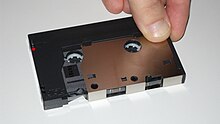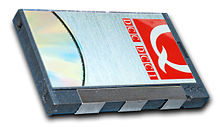Digital compact cassette
The digital compact cassette was developed by Philips and Matsushita , introduced in 1992 and discontinued in 1996 as an alternative to the traditional analog compact cassette , which is also a Philips development.
The digital compact cassette was initially referred to internally as S-DAT (Static-heads Digital Audio Tape) because of its similarity to the professional DAT recording system. DCC players were able to play the conventional analog compact cassette; however, recording was only possible on DCC tapes.
Compared to the conventional analog compact cassette (CC), the DCC offers significantly better sound quality due to the following technical details:
- Frequency range for 48 kHz DCC recordings 20 Hz to 22 kHz - in comparison the analog CC 20 Hz to 18 kHz (under ideal conditions such as the use of pure iron band and at −20 dB)
- Signal-to-noise ratio of a DCC> 92 dB - in comparison the analog CC> 50 dB (for the tape type chromium dioxide)
Like MP3 or the MiniDisc , this medium also uses data reduction . A system called “PASC” (Precision Adaptive Subband Coding) was used for this, which compressed the piece of music to about 1: 4 . PASC is almost identical to MPEG-1 Audio Layer 1 and works with a data rate of 384 kbit / s.
In contrast to the direct competing product - the MiniDisc - this system did not have any initial problems with the sound quality. However, handling deficiencies stood in the way of further dissemination. Finding a song in the middle of a 90-minute tape could take over a minute. Features to be found in the MiniDisc (deleting a track in seconds, moving it as required and, above all, the quick access to titles) could not be offered by this medium due to the system. However, the system also offered the option of entering the title and artist; some pre-recorded tapes even showed lyrics. Despite lower device prices and significant advances in operation (“TurboDrive” drive, 90-minute cassette rewound in one minute), the DCC was unable to establish itself.
The combination of the portable DCC recorder 175 with a standard Windows PC was revolutionary . As early as 1995, it was possible to transfer , edit and archive tracks directly from the audio recorder to the PC's hard drive via the parallel interface of the PC , or to operate the audio recorder directly from the PC using software.
There were also DCC streamers to use DCC for data backup . They disappeared from the market together with the DCC.
In the mid-1990s, due to the excellent sound properties of this system (18-bit resolution), they wanted to establish this system in studio production, but this failed. Ultimately, development and production were discontinued in 1996.
In terms of long-term stability, the DCC system has to struggle with similar defects that are known from analog cassettes: The tape is subject to constant wear and tear and progressive decomposition, which, despite digital error correction, in extreme cases leads to entire passages of recorded DCC failures after many years Tapes can no longer be played. The abrasion of the tape settles on the tape heads as dirt.
Web links
- The DCC cassette magnetbandmuseum.info
- Forgotten Audio Formats: DCC & Elcaset (from 0:06:21) on YouTube , May 6, 2014, accessed June 10, 2019.
- Rare DCCs and the mystery of the missing lyrics on YouTube , April 12, 2019, accessed June 10, 2019.





